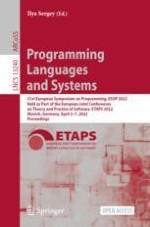Open Access 2022 | Open Access | Book

Programming Languages and Systems
31st European Symposium on Programming, ESOP 2022, Held as Part of the European Joint Conferences on Theory and Practice of Software, ETAPS 2022, Munich, Germany, April 2–7, 2022, Proceedings
Editor: Ilya Sergey
Publisher: Springer International Publishing
Book Series : Lecture Notes in Computer Science